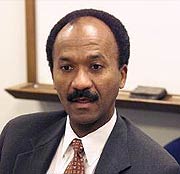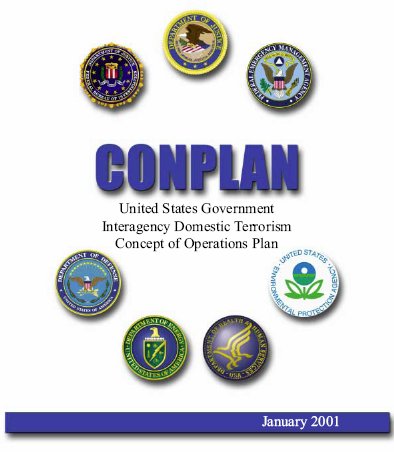Technocratic Coup d'Etat
The most exhilarating moment in any analysis project comes when a key piece of information is found that connects the threads of the system being analyzed. (To each his own you know :) That point came when I was writing the webpage of documentation titled "The Stalking Horse" and the connections were between The Club of Rome, the LBJ initiated, Soviet-American International Institute of Applied Systems Analysis conceived in 1966 and chartered in 1972; and the "The Great Society". What LBJ did with his treasonous authorization for covert, government funded fraternizing with the enemy, was to authorize a Super-Empowered Technocratic Tyranny to be unleashed on the world. It's no longer conspiracy theory. It is conspiracy fact.
Tyranny by Design
These Technocrats have the world so screwed up, that people all over the world are rioting and angry, 100's of millions of people are starving, governments are falling and the world is on the verge of exploding with violence. The hubris of these Ivory Tower Technocrats is mind-boggling. They are designing and global leaders are attempting to implement global, one-size fits all systems. To say that there are logical flaws in this plan is as laughably absurd as the idea of Global Technocratic Central Planning itself. One would be tempted to say, "It ain't working boyz", but is that true?
People nearly
always make the assumption that the stated goals and objectives are as
they are presented to be. But if that's true, then why has there
been no course correction when are obvious and stunning
failures? If failure
is rewarded, then failure was the objective and if failure was the
objective, then the stated goals and objectives were lies. At that
point, you must invert goals and objectives to derive the real agenda.
That puts the right perspective on things because in the real world,
only success is rewarded. Not failure.
Global Systems
In prior research (Digital Fascism of the Dons of Davos), I documented the G8 Summit meetings from 1990 forward where "collective" decisions were made for the world with the Houston summit being pivotal in terms of setting a course to fly the Starship Enterprise into the sun. Bad decision - another understatement. (From this point on, just apply this formula to the understatements: (x * galactic).
The decision made in Houston was to integrate all of the economies of the world under the authority of an International Trade Organization which they called the World Trade Organization. The idea for an international organization to manage trade among nations was first proposed in 1947 and the American Senate refused to ratify it because of sovereignty issues but what they hey right? Sovereignty is such a provincial idea - at least according to some.
In February of 1995, the G-7 Information Society Conference was held in Brussels. The original link to the EU website where this information was stored was no longer available but the webpage was recovered using the wayback machine: 1995 G7 Information Society Conference.
The European Commission hosted this conference following the G7 Naples Summit of 9 July 1994, when the Heads of State and Government decided that a meeting should be organised in Brussels to give ministers the opportunity of discussing the means by which to "encourage and promote the innovation and development of new technologies, including, in particular, the implementation of open, competitive, and world-wide information infrastructures". At this conference they identified a number of selected projects where international co-operation could be an asset. These projects would aim at demonstrating the potential of the Information Society and stimulate its deployment. In 1998 it was decided that all G7 Pilot Projects are called "G8 Pilot Projects", with the joining of Russia.
In an article titled, G-7 Ministerial Conference on the Global Information Society: Making Way for the New by Destroying the Old Civilization, Vigdor Schreibman wrote:
Washington, DC--The European Union, chaired by President Jacques Santer will host the G-7 Information Society Conference Feb 25-26, 1995, at Brussels, Belgium. The U.S. Delegation will be led by Secretary of Commerce Ronald H.Brown. Vice President Gore will deliver the keynote address at a luncheon Feb 25th. The Clinton Administration has stated that it wants to achieve support from the G-7 on five basic principles for building the GII:
1. encouraging private investment;
2. promoting competition;
3. creating a flexible regulatory environment;
4. providing open access to networks and services for providers and users;
5. and ensuring universal service.
The Administration gave a detailed description of these principles in a paper released Feb 16, "The Global Information Infrastructure: Agenda for Cooperation" [Fins-II2-03].
The Global Information Infrastructure: Agenda for Cooperation
One of the documents produced for the 1995 Information Society Summit in Brussels was a report that was listed as "The Complete Report". When the link was opened, the title of the report was, "The G8 Global Information Society Pilot Projects - Final Report". The following are the eleven initial Global Systems for the Global Totalitarian "Governance" System.
G8 Global Pilot
Projects
Global Inventory Project (GIP)
Implemented as an infrastructure of
decentralised national inventories, the Global Inventory
Project has established a single access point for information on
approximately 4000 projects
and studies on the development of the global information society. Many
sites all over the
world are accessible on a multilingual basis, and interest in this
inventory is still growing.
Global Interoperability of Broadband
Networks (GIBN)
This project has accelerated the development of globally interconnected
and interoperable
broadband information infrastructure, essential to the global
information society of the 21st
century. It demonstrated a series of advanced broadband applications,
raised the general awareness of their potential and contributed to the
development and deployment of advanced technology, products, services
and networks.
Transcultural Education and
Training for Language Learning (Tel*Lingua)
The project aimed to give producers, teachers, trainers and citizens a
single access point to resources and experiences for language and
transcultural learning through an international network of servers. An
operational prototype was set up and helped to lay the ground for
several virtual language servers. These services follow similar
structures in different languages.
Electronic Libraries:
Bibliotheca Universalis
This cultural project has coordinated part of the digitization
programmes of the participating
libraries through an agreed theme for document digitization “Exchanges
between people”. It
also led to the establishment of a formal agreement to pursue this
cooperation on organisational
and technical aspects.
Multimedia Access to World
Cultural Heritage
The project has coordinated the combined experience gained by each
country in the field of
methodological and technological standards thus enhancing the
international multilanguage
heritage with specific projects such as the Multilingual Thesaurus of
Religious Objects of the
Roman Catholic Church.
Environment and Natural
Resources Management (ENRM)
The project created the necessary tools for establishing a “virtual
library” of environmental
and natural resources management using international standards for
networked information,
discovery and retrieval. It reached an international consensus on a
Global Environmental
Information Locator Service for climate change, biological diversity and
other resources.
Global Emergency Management
Information Network Initiative (GEMINI)
GEMINI covered through demonstration projects and conferences the areas
of networks,
communication, support functions and specific hazards with the aim of
taking advantage of
information society tools to help in emergency management on a global
scale. The project has
been instrumental in laying the ground for a follow-up initiative to
develop a Global Disaster
Information Network.
Global Healthcare Applications (GHAP)
Subprojects demonstrated how medical databases, images, health cards and
computer based
training material can be used internationally, and how remote second
opinions in the diagnosis
and treatment of cancer and heart diseases can be achieved. The project
contributed to the setting of global standards.
Government On-Line (GOL)
The project focused on ways of providing on-line services to citizens.
Collaboration in 32 key
subject areas has resulted in shared approaches, identified best
practices, and given added impetus on the development of new policies
and actions around the world.
Global Marketplace for Small and
Medium Enterprises (SME)
Concentrating on increased competitiveness and participation in global
trade for smaller companies, the project set up an international
business information network on the Web. It
successfully catalysed a common vision of electronic commerce policy
development around
the world, supported some thirty international testbeds and published a
best practice guide for
SMEs.
Maritime Information Society (MARIS)
MARIS supported applications of information technologies in the maritime
sector - creating
synergies and new solutions for the benefit of maritime industries. The
project actively contributed to standardisation in the field and
established global and regional maritime information and collaboration
networks.
On page 9 of the Final Report, it says:
The pilot projects have given an important input to policy development and have led to international agreements.
In line with the Ministerial decision in Brussels in 1995, the pilot projects were implemented
without the creation of new bureaucracies or institutions, and were financed by existing programmes.
That second statement tells you why you can't see - and didn't know about the real "New World Order". It's because it's a technocratic tyranny implemented at the administrative levels of government. You have to dig into the details of legislation to find the evidence of it because by all external appearances, nothing has changed about our government. Internally, everything changed and it is no longer "our" government. They are simply an extension of the Global Technocracy. That should explain to you why there are so many un-American mandates being handed down to the state governments to be imposed on the American people. Examples would be the NAIS Animal Tracking System, the Supply Chain Food Safety System, the National Human Resource Management System (cradle-to-grave Integrated Education/Workforce Development System, etc.
The above legislation was authorized by extension of authorities issued by Presidential Executive Order 13011 which provided guidance for the implementation of legislation passed by Congress - and if you can follow that, then you're on the way to understanding how this subversive, subterranean network works.
Executive Order 13011
July 16, 1996
Federal
Information Technology
A Government that works better and costs less requires efficient and
effective information systems. The Paperwork Reduction Act of 1995 and
the Information Technology Management Reform Act of 1996 provide the
opportunity to improve significantly the way the Federal Government
acquires and manages information technology. Agencies now have the clear
authority and responsibility to make measurable improvements in mission
performance and service delivery to the public through the strategic
application of information technology. A coordinated approach that
builds on existing structures and successful practices is needed to
provide maximum benefit across the Federal Government from this
technology.
....
Sec. 4. Government Information Technology Services Board.
(4) be a focal point for liaison on information resources management, including Federal information technology, with State and local governments,
and with nongovernmental international organizations subject to prior consultation with the Secretary of State to ensure such liaison would be consistent with and support overall United States foreign policy objectives;(5) support the activities of the Secretary of State for liaison, consultation, and negotiation with intergovernmental organizations in information resources management matters;
Sec. 9. Department of State.
(a) The Secretary of State shall be responsible for liaison, consultation, and negotiation with foreign governments and intergovernmental organizations on all matters related to information resources management, including Federal information technology. The Secretary shall further ensure, in consultation with the Secretary of Commerce, that the United States is represented in the development of international standards and recommendations affecting information technology. In the exercise of these responsibilities, the Secretary shall consult, as appropriate, with affected domestic agencies, organizations, and other members of the public.
(b) The Secretary of State shall advise the Director on the development of United States positions and policies on international information policy and technology issues affecting Federal Government activities and the development of international information technology standards.
The legislation referred to in the first paragraph of EO 13011, was the Information Technology Management Reform Act of 1996 (ITMR). This is a little bit confusing because originally, it was in a section in the National Defense Reauthorization legislation but it applied to all government agencies. S.1124 Division E. There was another earlier bill called the Federal Acquisition Reform Act of 1995 (FARA) that was not passed, but it was included in S.1124 as a section that was titled, Federal Acquisition Reform Act of 1996. As best I can tell, there was an oversight in the legislation that had to do with the General Services Administration so they passed a correction bill that combined the ITMR and FARA into one bill with the correction and it was named the Clinger-Cohen bill after the authors of the legislation.
What they were doing with this legislation was to define and consolidate the organizational structure for information systems on a government wide level - including the military and they made the Director of the Office of Management and Budget (OMB) the head of the organization. In all organizations, there is the apparent power and then there is the real power. The Director of the OMB has the real power in the American Government and I'd be surprised if you even know his name.
Alice Rivlin was the Director of the OMB when the reorganization of government legislation was passed. She issued the implementation memorandum to agency heads. Soon after, she left the OMB and became a Governor for the Federal Reserve and she served as Vice-Chair to Alan Greenspan. Franklin Raines was appointed to fill the vacancy.
In 1996,
Franklin
Raines was the Director of the OMB.
He issued
the memorandum to the agencies of government authorizing the agencies to
integrate information systems across agency boundaries. For a
visualization of that, think of 'Total Information Awareness' and the
National Human Resource Management System (Integrated, cradle-to-grave
education and workforce systems for management of the American labor
market).
Franklin Raines then went on to work for Fannie Mae. The rest
is history in terms of the economy.
Alice Rivlin

She was appointed by President Lyndon Johnson as Assistant Secretary for Planning and Evaluation, United States Department of Health, Education, and Welfare from 1968 to 1969. In 1971 she authored Systematic Thinking for Social Action. She was the first director of the newly established Congressional Budget Office during 1975–83. Under President Bill Clinton she served as the deputy director of Office of Management and Budget from 1993 to 1994, director of OMB from 1994 to 1996 (becoming the first woman to hold the position), and a governor of the Federal Reserve from 1996 to 1999, during which time she served as the Fed's vice-chair. Source Wikipedia.
Franklin Delano Raines

Raines was born in Seattle, Washington,
the son of a janitor. Raines
graduated from Harvard College, Harvard Law School; and Magdalen
College, Oxford University as a Rhodes Scholar.
Source Wikipedia.
Interagency Domestic Terrorism Concept of Operations Plan Published
Release Date: February 22, 2001
Release Number: HQ-01-009
Washington, DC -- FEMA, the FBI and five other federal agencies have developed and published a plan for responding to a terrorist threat or incident in the United States. The U.S. Government Interagency Domestic Terrorism Concept of Operations Plan outlines how the federal government would respond to a terrorist threat or incident, including one involving weapons of mass destruction.
The Departments of Justice, Defense, Energy, Health and Human Services, and the Environmental Protection Agency played key roles in the plan's development, which implements a Presidential directive issued in 1995.
The new plan establishes guidelines for assessing and monitoring a threat, notifying the appropriate agencies and deploying resources to coordinate a crisis and consequence management response.
In a terrorist event in the United States, the FBI is the lead agency for crisis management while FEMA is the lead agency for consequence management. Crisis management primarily refers to law enforcement functions to prevent, pre-empt, and terminate terrorism and apprehend and prosecute the perpetrators, while consequence management involves the emergency management functions to save lives, protect property, restore government services, and provide emergency relief.
CONPLAN
The CONPLAN was the short name for the 'Interagency Domestic Terrorism Concept of Operations Plan' referenced in the above press release.
Notice that it
is an "interagency" plan - meaning that it was authorized as a result of
the government reorganization of authorized by Alice Rivlin and Franklin
Raines in response to the Clinger-Cohen legislation.
The following is an excerpt from the
Foreward of the CONPLAN:
FOREWARD
Publication of the United States Government
Interagency Domestic Terrorism Concept of Operations Plan (CONPLAN)
represents a concerted effort by a number of Federal departments and
agencies to work together to achieve a common goal. The CONPLAN was
developed through the efforts of six primary departments and agencies
with responsibilities as identified in Presidential Decision
Directive/NSC-39 (PDD-39). This plan has been developed consistent with
relevant PDDs, Federal law, the Attorney General’s Critical Incident
Response Plan, the PDD-39 Domestic Guidelines, and the Federal Response
Plan and its Terrorism Incident Annex. The FBI has worked with these
departments and agencies to provide a forum to participate in planning
and exercise activities in order to develop, maintain, and enhance the
Federal response capability.
To ensure the policy in PDD-39 and PDD-62 is implemented in a
coordinated manner, the CONPLAN is designed to provide overall guidance
to Federal, State and local agencies concerning how the Federal
government would respond to a potential or actual terrorist threat or
incident that occurs in the United States, particularly one involving
Weapons of Mass Destruction (WMD). The CONPLAN outlines an organized and
unified capability for a timely, coordinated response by Federal
agencies to a terrorist threat or act. It establishes conceptual
guidance for assessing and monitoring a developing threat, notifying
appropriate Federal, State, and local agencies of the nature of the
threat, and deploying the requisite advisory and technical resources to
assist the Lead Federal Agency (LFA) in facilitating interdepartmental
coordination of crisis and consequence management activities.
In June of 1995, President Clinton issued PDD-39.
Presidential Decision Directive 39 (PDD-39)
MEMORANDUM FOR THE VICE PRESIDENT
THE SECRETARY OF STATE
THE SECRETARY OF THE TREASURY
THE SECRETARY OF DEFENSE
THE ATTORNEY GENERAL
THE SECRETARY OF HEALTH AND HUMAN SERVICES
THE SECRETARY OF TRANSPORTATION
THE SECRETARY OF ENERGY
ADMINISTRATOR, ENVIRONMENTAL PROTECTION AGENCY
ASSISTANT TO THE PRESIDENT FOR NATIONAL SECURITY AFFAIRS
DIRECTOR OF CENTRAL INTELLIGENCE
DIRECTOR, UNITED STATES INFORMATION AGENCY
CHAIRMAN OF THE JOINT CHIEFS OF STAFF
DIRECTOR, FEDERAL BUREAU OF INVESTIGATION
DIRECTOR, FEDERAL EMERGENCY MANAGEMENT AGENCY
SUBJECT: U.S.
Policy on Counterterrorism (U)
It is the policy of the United States to deter, defeat and respond
vigorously to all terrorist attacks on our territory and against our
citizens, or facilities, whether they occur domestically, in
international waters or airspace or on foreign territory. The United
States regards all such terrorism as a potential threat to national
security as well as a criminal act and will apply all appropriate means
to combat it. In doing so, the U.S. shall pursue vigorously efforts to
deter and preempt, apprehend and prosecute, or assist other governments
to prosecute, individuals who perpetrate or plan to perpetrate such
attacks. (U)
We shall work closely with friendly governments in carrying out our
counterterrorism policy and will support Allied and friendly governments
in combating terrorist threats against them. (U)
One would have to have a concrete block for a brain not to see that the CONPLAN was the U.S. implementation of the Global Emergency Management Information Network Initiative (GEMINI) especially since FEMA appears to be the lead agency. The Brussels Conference was in February of 1995, PDD-39 was issued in June of 1995, the CONPLAN was published in January of 2001, and on September 12, 2001, it became operational. What a "lucky break".
In an article by Steven J. Tomisek published by the Institute for National Strategic Studies of the National Defense University, titled, "Homeland Security: The New Role for Defense", he lists all of the plans that were set to roll out immediately after September 11. It's an important that should be read, not excerpted. There is another article published in the National Defense Magazine from a paper written by members of the 2002 class of the Industrial College of the Armed Forces and the National Defense University titled, "Homeland Security Mobilization Requires Greater Coordination" that is worth reading.
In 2002, the legislation to create the Department of Homescam Security was passed into law. The Congressional Research Service published a report on the legislative history. And what do you know, there was legislation pending in March 2001 to create a Department of Homescam Security:
March 21, 2001 H.R.1158, to establish the National Homeland Security Agency, introduced by Representative Thornberry. Referred to Committee on Government Reform.
Technocratic Tyranny
The point of this exercise was to demonstrate how the Technocratic Tyranny operates. As I've said before, all of it traces back to the Super-empowerment of Systems Analysts to design technocratic solutions as they perceive them to be - not just nationally, but globally. I could have as easily selected the Global Health System and demonstrated the same thing.
As I write this, it brings to mind a question that I was asked by an IT Manager at the Municipality of Anchorage where I was working on contract in about 1983. She asked me if I thought that systems could be designed based on the data alone as opposed to the functions. I said no but I didn't really dwell on the question because I was busy. But today, nearly three decades later, I have a better answer for the question. You can't design systems based on the data alone because the data are only a symptom of the problem. The data doesn't define the problem. That's why technocratic solutions designed using Econometrics can't work. It's designing solutions from inside a black box. Any solutions designed this way only correct the reports - not the real problems. I realize that flies in the face of conventional wisdom concerning the infallibility of economists but my response to that is, they've been in charge for about 50 years now. How's it working out for you?
Vicky Davis
May 12, 2010

